 |
Home | Charity | Feedback |
Spain:
Barcelona,
Madrid,
Marbella,
Puerto Banus,
Seville,
Toledo
Toledo, Spain: The Imperial City by Prakash Bang, Editor in Chief 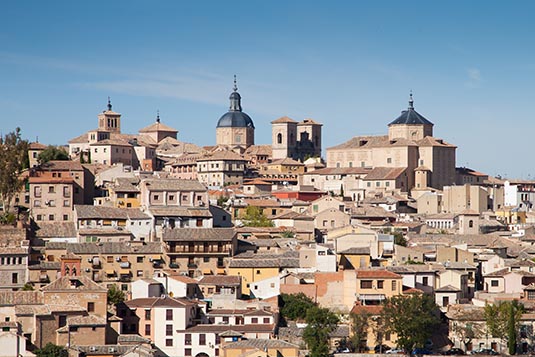 Toledo is known as the "Imperial City" for having been the main venue of the court of Charles V, Holy Roman Emperor, and as the "City of the Three Cultures", having been influenced by a historical co-existence of Christians, Muslims and Jews. 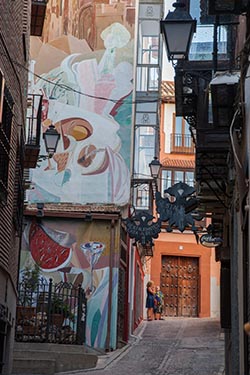 We took a fast train, AVE, from Madrid's Atocha station. The distance of 44 miles to Toledo took just 33 minutes. As soon as we entered the inside of the station, we were fascinated by the old-world charm of the station building as well as its interiors. It surely didn't looked like a station from any angle. It was evident that the rest of the day we would be transported back in history.
We took a fast train, AVE, from Madrid's Atocha station. The distance of 44 miles to Toledo took just 33 minutes. As soon as we entered the inside of the station, we were fascinated by the old-world charm of the station building as well as its interiors. It surely didn't looked like a station from any angle. It was evident that the rest of the day we would be transported back in history.
The history of Toledo is as rich as any other city in Europe, and it essentially starts with the arrival of the Romans in and around the second century BC. After the Romans came the Visigoths. The Visigoth kingdom fell into decline relatively quickly due to its feuding nobles, and in the early 700s, the Muslims moved in and assumed control. Toledo flourished during the Muslim era, as some of the greatest Muslim, Christian, and Jewish minds of the time congregated there in good number. Even after the Christian forces assumed control of Toledo in 1085, Muslims and Jews coexisted peacefully with Christians for a relatively long period. This all changed in and around 1492, however, after the Catholic Monarchs conquered Granada, effectively ending the Muslim era in Spain. As far as historic facts about Toledo Spain are concerned, it bears noting that the city served as the Spanish capital for a period during the 1500s. 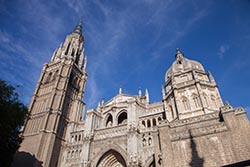 Because we had only half a day with us, it was a good idea to take the Toledo Hop-On-Hop-Off bus. Thankfully, a bus was waiting for us at the station. The bus route goes around the town offering majestic views of the town, the surrounding landscape and the Tajo River that engulfs the town of Toledo. A panoramic view point stop is quite awesome. We alighted just before the last stop, on the edge of the hill, and walked our way up to negotiate the old town.
Because we had only half a day with us, it was a good idea to take the Toledo Hop-On-Hop-Off bus. Thankfully, a bus was waiting for us at the station. The bus route goes around the town offering majestic views of the town, the surrounding landscape and the Tajo River that engulfs the town of Toledo. A panoramic view point stop is quite awesome. We alighted just before the last stop, on the edge of the hill, and walked our way up to negotiate the old town.
We had time on hand to lose in Toledo's medieval streets. The city is surrounded by the River Tajo on three sides and two medieval walls on the fourth side. The old city is relatively small and can be crossed in 45 minutes, so we were never too far from the center. When lost, just head back uphill and you are virtually guaranteed to end up at the main plaza, Plaza de Zocodover. From this plaza, we began our walk, not really knowing the route that we would be taking! There is a "Land Train" operating from the centre of the town. A good way to look around, particularly if you can't walk too far. We avoided the joy ride though. 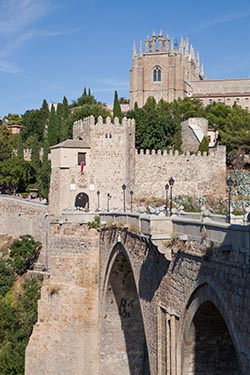 Two of the top Toledo Spain sites are the Alcazar and the Cathedral. Originally built in the tenth century, the Alcazar is a Muslim-era fortress that was eventually altered by the Christians. The Alcazar had to be rebuilt after a famous siege led to it being largely destroyed in the 1930s. This siege related to the Spanish Civil War. After being rebuilt, the Alcazar was converted into an army museum. Sadly, it was closed for visitors during our time of visit.
Two of the top Toledo Spain sites are the Alcazar and the Cathedral. Originally built in the tenth century, the Alcazar is a Muslim-era fortress that was eventually altered by the Christians. The Alcazar had to be rebuilt after a famous siege led to it being largely destroyed in the 1930s. This siege related to the Spanish Civil War. After being rebuilt, the Alcazar was converted into an army museum. Sadly, it was closed for visitors during our time of visit.
As for the Cathedral, it is arguably the best of the Toledo Spain sites. Considered a Gothic masterpiece, the Toledo Cathedral actually features a few different architectural styles. Toledo has long been the Catholic center of the country, and the city's Cathedral, which was built between 1226 and 1493, reflects this in impressive fashion. No visit to the city would be complete without exploring the Jewish Quarter. While most of the synagogues that once stood in the Jewish Quarter were destroyed over time, two remain. These synagogues include the Sinagoga del Transito and the Sinagoga de Santa Maria La Blanca. The former was built in 1355 and now houses the excellent Museo Sefardi, while the latter was erected in the late 1100s and is noted for its graceful arches and ornamental accents. 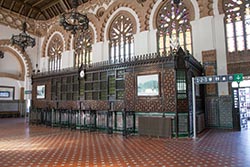 To be honest, I had no idea about the direction that I was taking. It was actually an aimless, but mesmerising walk... the cobbled streets, alleys, the ups and downs, the steps, the architecture, the masonry were awe inspiring. Keeping in mind the principle of 'walk uphill' saw us back at Plaza Zocodover.
To be honest, I had no idea about the direction that I was taking. It was actually an aimless, but mesmerising walk... the cobbled streets, alleys, the ups and downs, the steps, the architecture, the masonry were awe inspiring. Keeping in mind the principle of 'walk uphill' saw us back at Plaza Zocodover.
We took a city bus back to the station and took the train to reach Madrid. The next morning we would leave for Barcelona. Toledo Image Gallery  Photo viewer Photo viewer
|
|
|
Home |
Charity |
Feedback
Privacy Policy | Terms of Usage © YoGoYo.com. All rights reserved. |









































